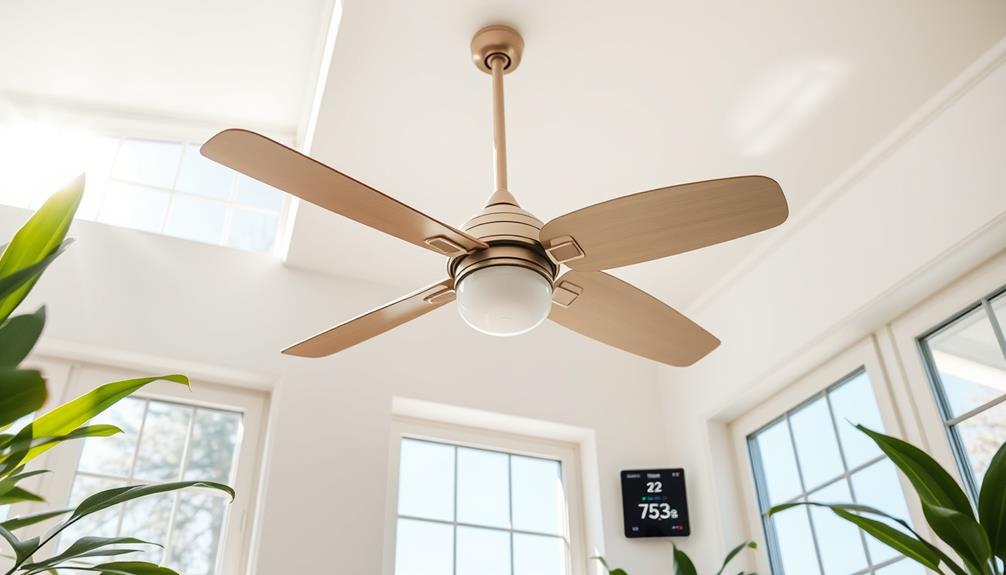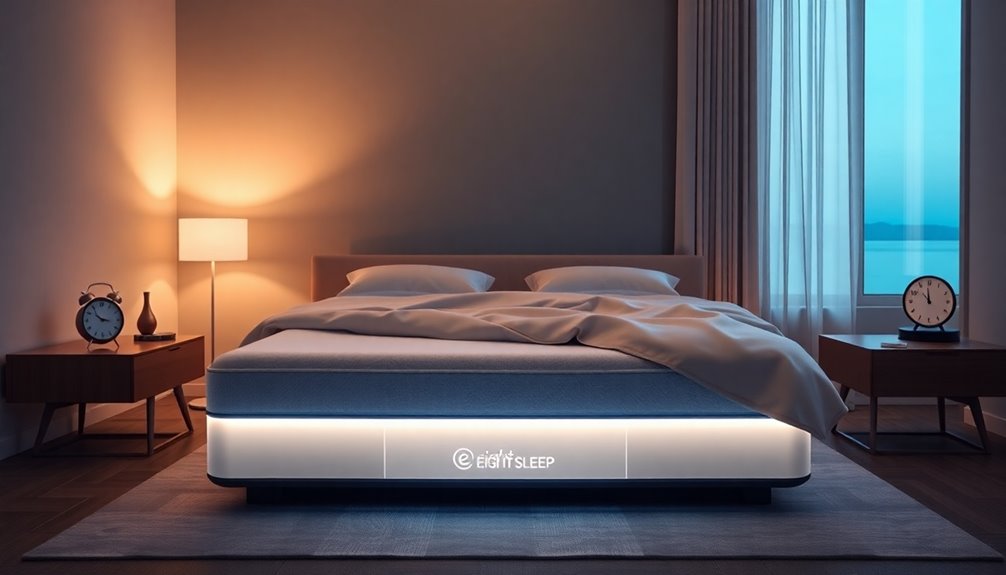Revealing the secrets to ceiling fan energy efficiency begins with understanding how airflow and wattage work. It is recommended to choose Energy Star certified fans, as they have the potential to allow you to increase your thermostat setting by up to 4 degrees Fahrenheit, resulting in energy savings. When selecting a fan, look for models with DC motors and LED lighting to maximize efficiency. To ensure optimal performance, adjust the speed settings of your fan according to the conditions and ensure regular maintenance. By combining your ceiling fan with an AC system, you can further increase comfort while reducing costs. For those looking to discover additional ways to increase energy savings, there are numerous tips and tricks to explore.
Key Takeaways
- Choose Energy Star certified fans to maximize energy savings and ensure compliance with efficiency standards.
- Opt for fans with DC motors for superior energy efficiency compared to traditional AC motors.
- Adjust fan speed settings according to conditions to enhance comfort while minimizing energy consumption.
- Regular maintenance, including cleaning and lubrication, extends fan lifespan and improves overall efficiency.
- Combine ceiling fans with air conditioning to optimize cooling and reduce energy costs effectively.
Understanding Ceiling Fan Efficiency
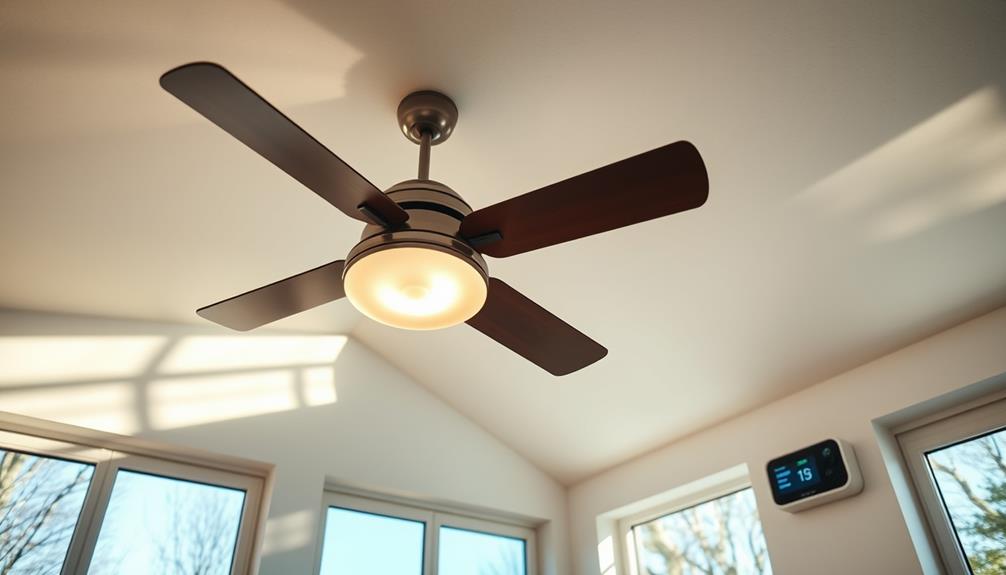
Understanding ceiling fan efficiency starts with analyzing how much energy a fan consumes compared to its airflow output.
Modern Energy Star certified fans can raise thermostat temp by 4°F, which can greatly impact energy savings. You'll want to evaluate wattage, which refers to energy usage, and CFM (cubic feet per minute), which indicates airflow effectiveness. This relationship helps you gauge how efficiently a fan operates.
Energy-saving technologies, like LED lighting and DC motors, can enhance efficiency, as they often consume less power while maintaining airflow. When comparing fans, look for those with lower wattage ratings that still deliver sufficient airflow.
Additionally, check for Energy Star certification, which signifies compliance with rigorous efficiency standards. By focusing on these aspects, you can make informed choices that reduce energy costs and improve comfort in your space while also enhancing airflow and reducing reliance on air conditioning stylish designs.
Key Factors Affecting Wattage
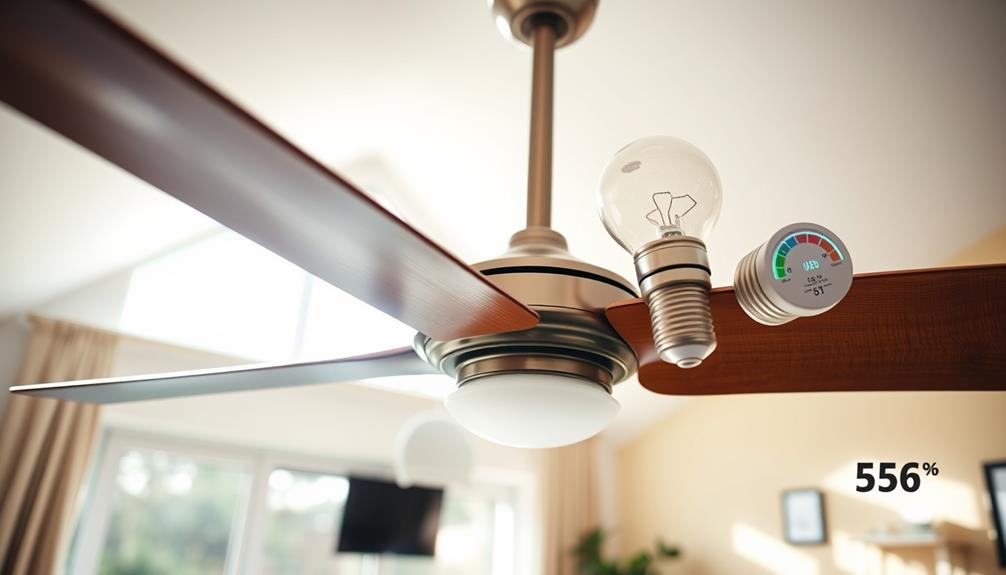
When choosing a ceiling fan, several key factors directly influence its wattage and energy consumption.
First, consider the fan's size; larger fans often use more wattage, so pick a size that fits your space.
Blade length and design also matter; wider blades can move air more efficiently, potentially reducing wattage needs.
Next, think about the motor type. DC motors are generally more energy-efficient than AC motors, consuming less power. When choosing the right motor for your garage door opener, it’s essential to consider your specific needs and usage patterns. For instance, if you require a reliable and consistent opening mechanism that can handle frequent use, a DC motor may be the better option, as it tends to provide smoother operation and quieter performance. Whether you’re looking to enhance convenience or simply need a dependable solution to power up your garage door opener, selecting the appropriate motor type will ensure optimal functionality and efficiency.
Additionally, the speed settings play an essential role; operating at lower speeds can greatly decrease wattage usage.
Calculating Energy Consumption
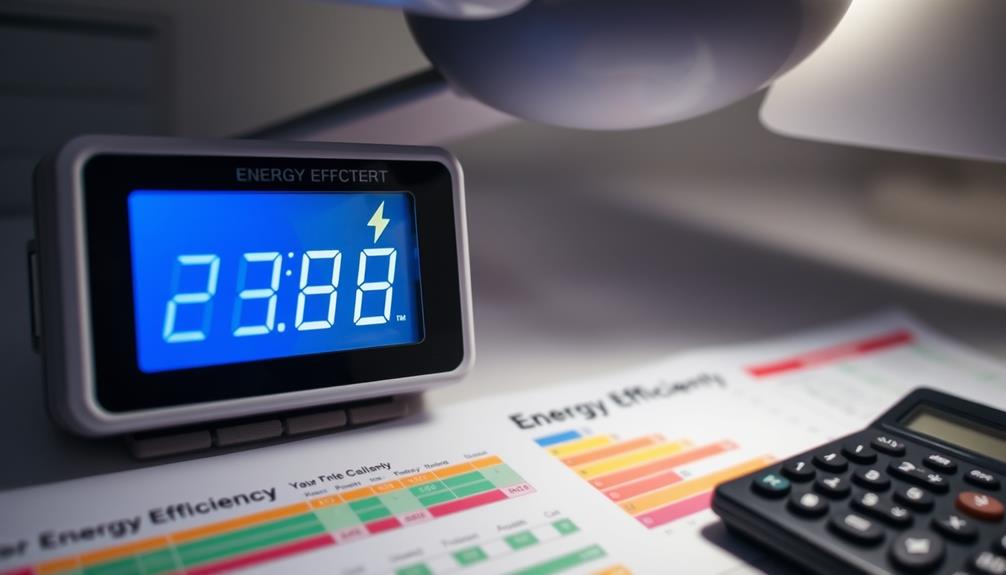
To effectively manage your ceiling fan's energy consumption, it's important to calculate its power usage accurately.
Start by checking the power rating, usually found on the fan's label or in the manual. This rating indicates how many watts your fan uses.
Next, measure how many hours you run the fan each day. Multiply the wattage by the number of operating hours to find daily consumption in watt-hours.
For example, a 60-watt fan running for 4 hours uses 240 watt-hours. You can multiply this daily figure by 30 for a monthly estimate.
Cost and Safety Implications
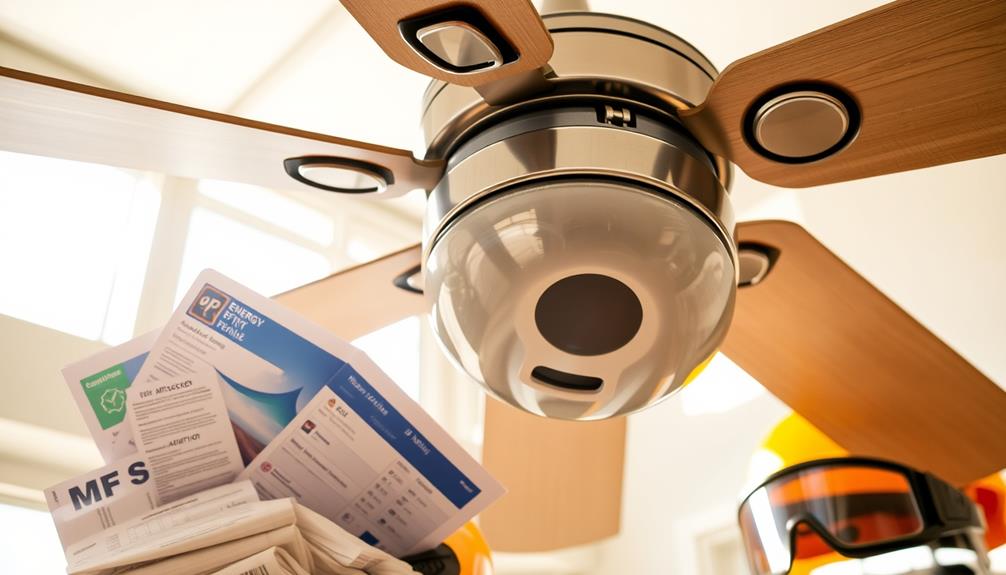
Ceiling fan energy efficiency can greatly impact your electricity bills and safety at home. When you choose a fan with lower wattage, you not only save money on your utility bills but also reduce the risk of overloading electrical circuits.
High wattage can lead to overheating, potentially causing fire hazards. Maintaining your ceiling fan is essential; regular cleaning and lubrication can improve its efficiency, extending its lifespan and keeping your home safe.
Additionally, using appropriate speed settings allows you to manage energy consumption effectively. Remember, higher wattage doesn't always mean better cooling.
Prioritize energy-efficient models to protect both your wallet and your home, ensuring a safe and comfortable environment for you and your family.
Choosing Energy-Efficient Models
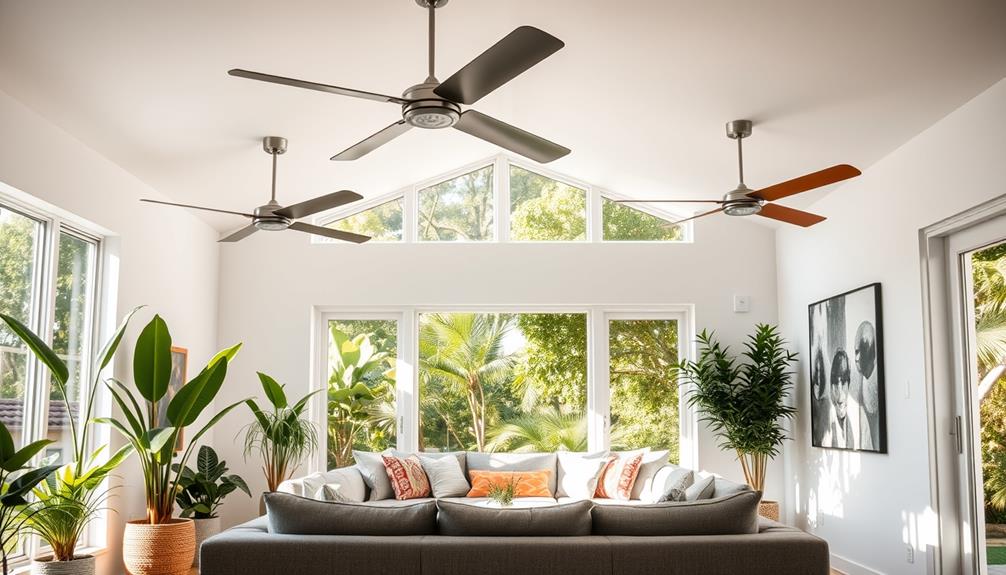
Choosing an energy-efficient ceiling fan can make a noticeable difference in your energy bills and comfort level at home. When selecting a model, look for fans with DC motors, which use less power than traditional AC motors. Opt for fans that come with LED lighting, as they consume considerably less energy than incandescent bulbs. Additionally, check for ENERGY STAR certification to guarantee you're choosing a model that meets strict efficiency guidelines.
| Feature | Benefits | Considerations |
|---|---|---|
| DC Motors | Higher efficiency | Slightly higher upfront cost |
| LED Lighting | Lower energy consumption | May require compatible fixtures |
| ENERGY STAR Rated | Meets efficiency standards | Confirm proper installation for best performance |
Optimizing Fan Performance
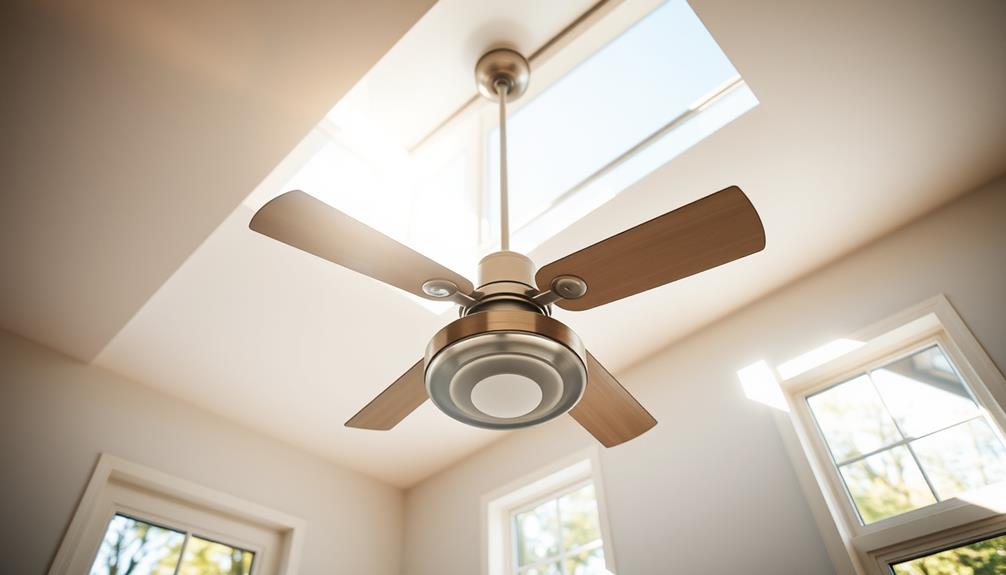
After selecting an energy-efficient ceiling fan, optimizing its performance is essential to maximizing energy savings and comfort in your space.
Start by choosing the right speed setting for your needs; using lower speeds reduces energy consumption while still providing airflow.
Install a fan speed controller to easily adjust settings based on the season or time of day.
Regular maintenance is also vital—clean blades and lubricate moving parts to enhance efficiency and prolong lifespan.
Finally, verify your fan is appropriately sized for the room; a well-matched fan can circulate air more effectively, creating a more comfortable environment without excessive energy use.
Combining Fans With AC Systems
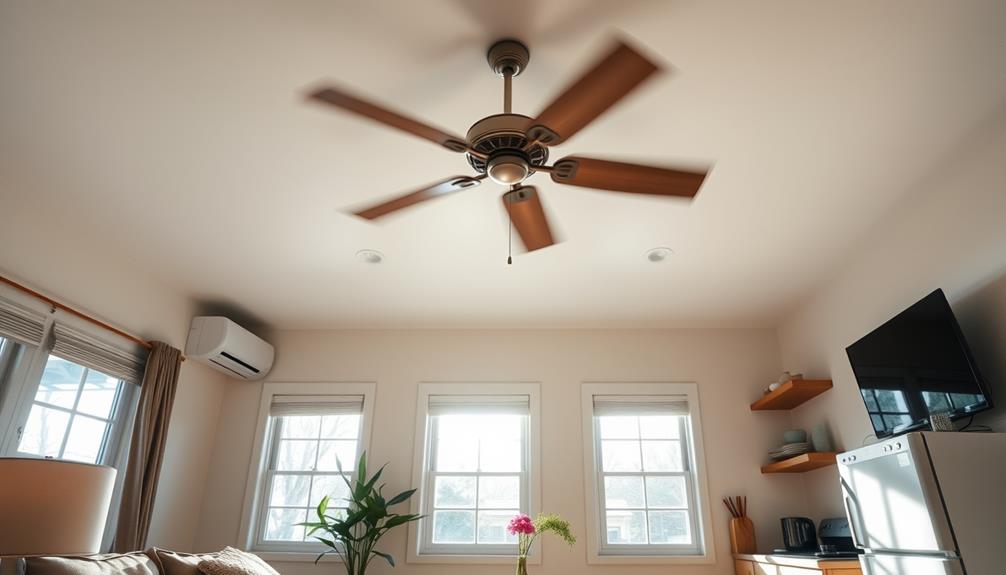
When you combine ceiling fans with your air conditioning system, you can markedly enhance comfort while reducing energy costs. By using fans to circulate cool air, you allow your AC to operate more efficiently, which lets you raise the thermostat a few degrees without sacrificing comfort. This simple adjustment can lead to significant energy savings.
Position fans strategically to create a cross-breeze, guaranteeing cool air reaches every corner of your room. You should also run ceiling fans in a counterclockwise direction during summer to push cool air down.
Regularly maintaining both systems guarantees peak performance, helping you maximize energy efficiency. This synergy between fans and AC not only improves comfort but also extends the lifespan of your cooling systems.
Frequently Asked Questions
How Does Fan Blade Material Affect Energy Efficiency?
Fan blade material greatly impacts energy efficiency. Lighter materials, like plastic, reduce strain on motors, consuming less power. Heavier materials may enhance airflow but can require more energy. Choose wisely to optimize your fan's performance and efficiency.
Are There Specific Ceiling Fan Brands Known for Energy Efficiency?
Finding energy-efficient ceiling fan brands feels like searching for a needle in a haystack. You'll discover brands like Hunter, Casablanca, and Minka Aire that excel in energy savings while keeping your space comfortably cool.
Can Ceiling Fans Help Reduce Heating Costs in Winter?
Absolutely, you can use ceiling fans to reduce heating costs in winter. By running them in reverse mode, you circulate warm air, allowing you to lower your thermostat setting and save on energy bills.
What Is the Lifespan of Energy-Efficient Ceiling Fans?
When you choose energy-efficient ceiling fans, you're investing in durability. Typically, these fans can last 10 to 15 years, providing consistent performance while saving on energy costs, much like a wise investment that pays off.
How Do Installation Height and Angle Impact Fan Performance?
Installation height and angle greatly impact fan performance. You should mount your fan 8-9 feet above the floor and guarantee blades are angled correctly. This maximizes airflow and enhances cooling efficiency throughout the room.
Conclusion
By revealing the secrets of ceiling fan energy efficiency, you're not just saving money; you're creating a comfortable sanctuary in your home. Picture yourself enjoying a gentle breeze on a warm summer day, all while keeping your energy bills in check. With the right knowledge and choices, you can transform your living space into an eco-friendly haven. So, embrace these insights and let your ceiling fan work its magic, making comfort and savings dance together harmoniously.
